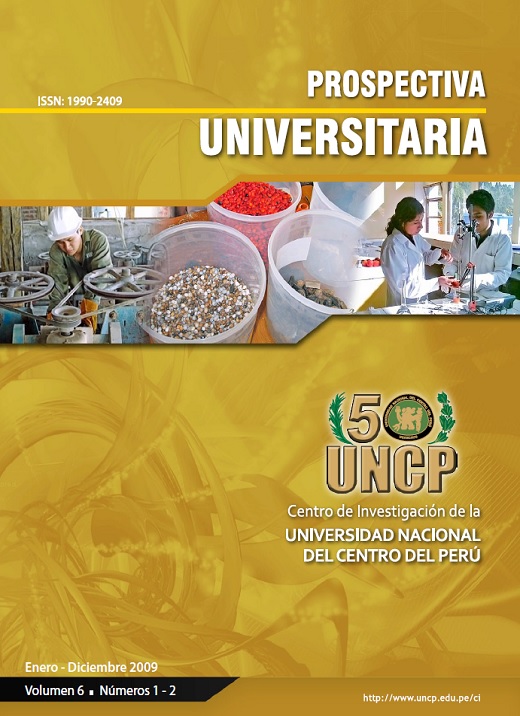PRODUCTIVE YIELD, NITROGEN AND RAW FIBER OF THE FORAGE OF WHITE BOLAINA (GUAZUMA SP.) CULTIVATED AS PROTEIN BANK, IN SATIPO
DOI:
https://doi.org/10.26490/uncp.prospectivauniversitaria.2009.6.1185Keywords:
bolaina, forage, yieldAbstract
The cattle agro forestry is presented as an alternative sustainable cattle rising; therefore, the objective of the study is to determine the productive yield during three periods post uniformity trimming, and to determine the nitrogen composition and raw fiber of the white Bolaina’s forage, cultivated as a protein bank. This study was carried out in the county of Satipo, department of Junín, at 674 meters above sea level, in the Experimental Area of the Agricultural Sciences Faculty in Satipo. For the study, 90 Bolaina Blanca seedlings were used, that aged 26 months post installation, distributed in 9 experimental units, each one of them with 10 seedlings. The independent variable was the post uniformity trimming period: treatment 1. 30 days post trimming; treatment 2, 60 days post trimming, and treatment 3, 90 days post pruning. The dependent variables were: yield of green forage, yield of dry matter, and the forage’s composition percentage of nitrogen and raw fiber. The variance analysis was used by a complete randomly blocks’ design, making use of the Duncan test at a significance level of 0.05. The best productive Bolaina yield was obtained at the 30 days post uniformity trimming, with 19.82 and 3.97 grams per green forage plant and dry matter respectively. The yields at 30, 60 and 90 days post uniformity was during dry times of the area. The protein content and raw fiber was r6.9% and 25.3% respectiely.
Downloads
References
Araya B. J. 1994. Identificación y caracterización de árboles y arbustos con potencial forrajero en Puriscal.Costa Rica: Centro Agronómico Tropical de Investigación y Enseñanza (CATIE).
Bazán A.L.; Granados M.M. 2007a. Establecimiento de Bancos Proteicos de Bolaina Blanca (Guazuma sp): Una Alternativa para la alimentación de ganado en selva. IIFCAS Universidad Nacional del Centro del Perú; Huancayo.
Fundación CIPAV. 2004. Proyecto Enfoques silvopastoriles integrados para el manejo de ecosistemas. Centro Agronómico Tropical de Investigación y Enseñanza (CATIE), Costa Rica. (Fecha de acceso 10 de diciembre 2007), URL Disponible en: http://www.cipav.org.co/redagrofor/proinvde/RPBM.htm.
Sánchez M.S. 2000. Sistemas agroforestales para intensificar de manera sostenible la producción animal en América Tropical. Roma: FAO.
REFOLASA. 2008. (Fecha de acceso 12 de diciembre 2008) Bolaina. Disponible en: http://www.refolasa.com/archivos/r_bolaina.jpg&imgrefurl.
Downloads
Published
Issue
Section
License
Copyright (c) 2021 Prospectiva Universitaria

This work is licensed under a Creative Commons Attribution-NonCommercial-ShareAlike 4.0 International License.
Esta Revista es de acceso abierto a su contenido a través del Internet, poniendo a disposición de la comunidad científica los resultados de la investigación, de manera gratuita, para el intercambio del conocimiento desarrollado.
El contenidos de la Revista se distribuyen bajo la licencia Creative Commons Reconocimiento-NoComercial-CompartirIgual 4.0 Internacional.
![IconJournalPU [ENG] by Edgar Julian-Laime®](https://revistas.uncp.edu.pe/public/journals/1/pageHeaderLogoImage_en.png)









